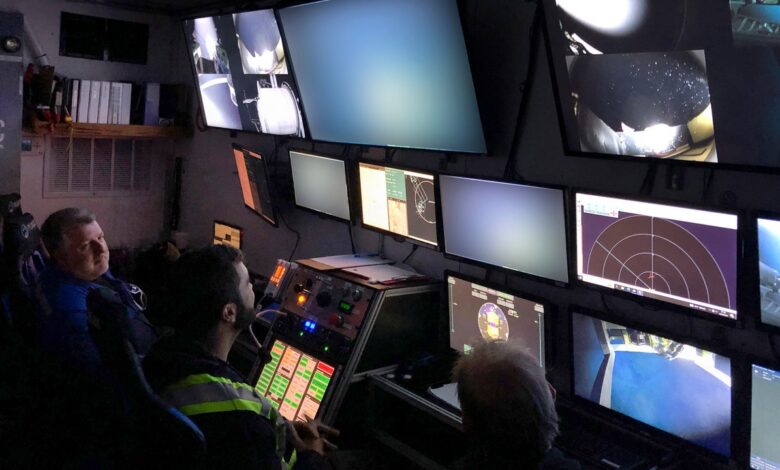Inside the ‘Titan’ Sub Recovery: A Hopeful Rescue Turned Tragic Mission

The Navy had assessed that their own readings of the same underwater event were “not definitive,” according to a naval official who spoke anonymously to The Wall Street Journal. And absent conclusive evidence of a catastrophic failure of the Titan’s pressure hull, another anonymous naval official told The New York Times, it would have been “irresponsible” not to persevere with the search. Every decision and action was being passed through the First District chief, Rear Admiral John Mauger, with the safety of dozens of men and women engaged in potentially risky aspects of the search now his responsibility. But Mauger also knew that from the moment a vessel in port received an instruction, it would take more than 30 hours for those orders to take effect on site in the mid-Atlantic. He had a difficult choice to make in no time. “There is a delay between when you say something and when you get the feedback from that decision,” he explained later. “We had that common understanding of what needed to get done, and that common intent, and folks continued to move out across the board.” The details of the acoustic anomaly were not made public.
On that Monday, June 19, the Bahamas-flagged Deep Energy, owned by UK- and Houston-based TechnipFMC, was nine days into a slow chug from Norway to a new project near Mobile, Alabama. Its capabilities include two onboard ROVs that can help oil and gas companies lay 16-inch steel pipes up to 3,000 meters underwater. Captain Ross Macleod heard about some aircraft chatter on the long-range search-and-rescue radio signal, VHF channel 16. Raised in the remote Outer Hebrides islands off Scotland’s northwest coast, Macleod had been at sea since high school, the past 10 years as a skipper. When his operations manager in Texas called to discuss the Titan, he had already planned how his vessel could be put to use. “I knew that we had sufficient wire rope on board with winches, which would be able to reach the bottom,” he remembers. “Immediately I understood that was going to be a useful tool, possibly a method of recovering the vehicle—the sub—if we happen to find it.” Within minutes of getting the green light, Macleod had turned the Deep Energy around and was hurtling toward the Titanic faster than its published top speed. “To be honest, my adrenaline starts pumping by this point,” recalls Macleod in his soft Scottish brogue. “I truly believed that we were a vessel—the best hope, I thought, for those souls at that time.”
Cassano, still at JFK, had ordered an Uber to his brother’s house in North Salem, New York, where he’d left his truck, and coordinated with the team of operators—scattered from Alaska to Texas—he would need to pilot their ROV. Cassano tried to rest there briefly, but sleep made little sense given the circumstances, and he gunned his truck north through the dawn, stopping frequently to join conference calls with OceanGate’s Griffith, Mauger, and other salvage experts from the US Navy.
Pelagic is headquartered inside an old truck maintenance depot in the leafy and clapboard-friendly village of East Aurora, New York. Thunder rolled overhead last summer when I visited the space, filled with a hulking yellow ROV, two strong aluminum grabbing hands at the front and a panoply of cameras affixed around its exterior. Like so many submersibles, it’s named for a figure from mythology, the charming, cunning, can-do Greek king Odysseus. In a typical year, Pelagic operators spend a third of their time at sea, working for half a dozen organizations, including Cassano’s former employer NOAA, whose projects they’ve supported through the mapping, surveying, and sampling of deep-sea coral in the Gulf of Mexico and South Atlantic. But last June, through sheer luck, Odysseus was available and ready for this unexpected deployment. By late afternoon Monday, Cassano himself had made it to Pelagic’s facility, where he found members of a nearby trucking firm, a clutch of colleagues, and even some neighbors helping to load Odysseus onto trucks for its first-ever rescue dive. Soon enough, four semis roared west to Buffalo Niagara International in upstate New York, where authorities cleared them straight onto the tarmac. While they waited to be loaded, Cassano began coordinating with the ship that had been hired in St. John’s, called the Horizon Arctic, to ensure its deck would be ready and its navigation system and power supply would be compatible.
On board the Polar Prince, Griffith had separately reached out to a former OceanGate employee now working for Woods Hole, who had in turn called principle submersible engineer Andy Bowen, who started plugging the names of suitably equipped scientific research vessels into a global map that tracks sea-traffic data. “It was really kind of a trip around the Horn to figure out who we might be able to call into action to help,” Bowen recalled—similar in some ways to another frantic logistical scramble in the frightening era of Dr. Strangelove. Back in 1966, Woods Hole’s Alvin sub had been suddenly called up to help end an extraordinary diplomatic furor, provoked when an American aircraft accidentally dropped an H-bomb off the coast of Spain. The circumstances of the accident had clearly undermined assurances made by US forces that they were not engaged in nuclear logistics on any of the bases they’d leased from Madrid. After 80 days of underwater searching and one failed winch effort, the bomb was eventually recovered without casualties.
As Bowen worked through his mental short list of the dozen or so submersibles worldwide that he knew could safely dive to the Titanic’s depth, the nearest he could find was on board Atalante, a French ship named for the only mythical Greek heroine allowed to join the all-male Argonauts. Bowen knew the vessel usually carried an ROV called Victor 6000, built to descend to 6,000 meters, and so reached out to a longtime friend at Ifremer, the French government agency that oversees the country’s oceanographic efforts. It turned out the Atalante was helping with a geophysical survey in the Azores. But after a flurry of communications between Cape Cod, Boston, Paris, and Brest in northwest France, the Atalante’s captain quickly charted a new course and “put the hammer down,” in Bowen’s words—racing for more than 48 hours northwest toward the Polar Prince in a bid to save one of its own. Paul-Henri Nargeolet, the Titan’s missing copilot, had once overseen Ifremer’s subsea operations, descending to the Titanic wreck several times in the agency’s older submersible, Nautile. Diving the far newer Victor 6000 to any depth would be difficult though, since the 10-man specialist team that usually operated it was not aboard the Atalante. Back at their base in France, they frantically started packing for a mid-ocean rendezvous.
60 HOURS
That Monday evening at Joint Base McGuire-Dix-Lakehurst in New Jersey, Captain Matthew Hahn got a fresh set of orders: There’d be no trip to Germany to pick up service members’ household items. Instead, he’d be making a quick swing through Dover Air Force Base in Delaware in his C-17 Globemaster III to pick up some pallets and an extended forklift system used on military cargo known as a K-loader. Then on to Buffalo, where he would collect heavy but delicate cargo that had never been airlifted. The Odysseus ROV would be difficult to tie down securely without damaging it—but any shift in weight during takeoff could also dangerously upset the aircraft’s trim over a heavily populated area. “None of it was normal, and none of it was what we’d ever seen before,” the senior loadmaster, Technical Sergeant Eric McKinley, recalled. But he and his colleagues had already grasped that Odysseus might be the Titan’s best hope: “We had to make this mission work.”
Many hours later, as Hahn descended over the rugged Atlantic coastline into St. John’s, the 27-year-old from Virginia concluded it was the worst landing in his two years of flying missions. A 20-knot right-to-left crosswind whipped across the slick and slippery asphalt, the visibility so poor that the ground only flashed into vision with 200 feet left, the lowest altitude at which his instruments would safely permit him to land manually. “I actually saw the lights leading up to the runway first before I saw the runway,” he says. In the cockpit of the C-17 behind him—one of three called upon to help transport the Odysseus and its accompanying equipment—Ed Cassano gripped the armrest as the pilots roared in for the turbulent touchdown. The already exhausted New Jersey crew members crashed at a nearby hotel, not realizing their import in the high-profile rescue until locals approached them the next day at Starbucks and then a grocery store to thank them.
36 HOURS
The St. John’s airport sits on a plain just north of town, with little room for the three vast US military aircraft that had been forced to parallel park there. On Pier 12, the Horizon Arctic’s tracked cranes hoisted 10- and 20-foot containers onto the deck, Pelagic’s engineers deciding their precise positioning—typically a weeklong task—in just minutes. A team of eight welders had worked through the night to ensure that the grillage—a steel base to which the Odysseus’s winch would be attached—was secure. At 8:30 p.m. local time, their blowtorches were still brazing as the last truck arrived from the airport. Cassano had told authorities it might take more than 24 hours to install the equipment, but they turned it around in 8, and after a brief safety inspection, the Horizon Arctic was cleared for departure. The vessel—owned by the same Newfoundland firm as the Polar Prince—had worked with OceanGate over the previous two seasons. Many of those on board, including the captain, knew Stockton Rush personally.
29 HOURS
The Horizon Arctic powered through the narrow entrance of St. John’s harbor by 4 a.m. Wednesday, past abandoned British and French cannon posts, with heavily forested hillsides to the starboard and a craggy windswept outcrop called Signal Hill on its port side. More than 111 years had elapsed since a message had reached the hill’s telegram station announcing that the Titanic had struck an iceberg. Learning this, Cassano felt his neck prickle. Adam Myers, the ship’s captain, instructed his chief engineer to push the engine to its limits, cresting at more than 17 knots to reduce the 400-mile journey to the southern edge of the Atlantic’s Grand Banks by an hour or more. “Every freaking minute was counting,” Cassano recalls, as the Pelagic team began prepping for their final task: the rescue itself.
The plan they had formulated with those on other vessels near the Polar Prince was relatively simple, based on the tools they had available. Encased in the polymer rope of the Odysseus’s miles-long umbilical cord were copper wires that power the vehicle below the surface, as well as fiber optic cables that feed imagery from the 8K cameras. It wasn’t built as a dedicated hoisting line, but the Pelagic team was confident it could lift 20,000 to 30,000 pounds of extra weight from the seafloor. OceanGate’s Scott Griffith, by then transferred from the Polar Prince to the Deep Energy, which was already on-site, had confirmed the Titan weighed around 23,000 pounds. Once the Titan was located and before ascending, Odysseus would maneuver a vast hook—known as a Crosby—and attach it to a shackle point on the Titan’s hull, as well as two beacons in case the prone sub somehow slipped back into the abyss and required relocating.
Given the weights involved, the Deep Energy’s ROVs would also concurrently dive to their maximum depth above the Odysseus, waiting to attach the Titan to the pipe-laying vessel’s far more robust rope and powerful winch, to help ease the burden for the remaining 2,700-meter lift. “We’re going down. We’ll grab them. We’ll come up, we’ll meet the other vehicle,” Cassano explained. “It’ll go get the lift line. Bang. We’ll lift them, we’re out.”
4 HOURS
After a full 24 hours of powering through the Atlantic swell, they reached the site and began coordinating with the Deep Energy, believing those on board the Titan might have only hours remaining. “I’m doing the math in my head,” Cassano recalls. “I know that when we arrive on-site, we probably have—I believe—plus or minus four.” Dozens of decisions, hundreds if not thousands of people, exponentially more phone calls and emails had kept hope alive, but there was now almost no margin for error remaining once the team factored in the time needed for the long descent, actually finding the Titan, and then the final leg up to the surface. “That time just goes so quickly. It was horrible. Every time I looked at the clock, another hour had passed,” said Deep Energy captain Ross Macleod, waking after just two hours of sleep. Nevertheless, “it was a moment of optimism,” as he described it, with his engineers planning how they might reprogram their winch system to make that final hoist even faster, before dragging the Titan up on deck and drilling a hole through its hull to provide oxygen to those inside as fast as possible.
Just before 2 a.m. local time, the Canadian Coast Guard’s Ann Harvey joined the cluster of vessels after its own race from St. John’s with the submersible crew that normally worked on the French Ifremer vessel, the Atalante. A choppy sea and dark fog made it difficult to ferry the 10 French ROV operators and their equipment several hundred feet across to the Atalante. Each of them raced up their ship’s ladder like a “scalded cat,” according to the Ann Harvey’s captain, to begin preparing their vehicle to dive as well. The dozen-strong flotilla began taking instruction on their positioning from the Horizon Arctic at that point; Cassano remembers the Deep Energy’s Macleod handing over responsibility ahead of their last-gasp effort with the words “This is your show.” Skipper Adam Myers was nearby on the Horizon Arctic’s bridge, he and Cassano “locked in” as they worked closely to initiate the delicate process of launching an ROV off a vessel that was rolling and pitching in 12-knot winds, its engines powering multiple vast propellers to maintain a precise position—yard by yard at times—for a secure start to the dive.
3 HOURS
Following several final checks, the Odysseus was lowered off the back and into the water to begin its faster-than-usual plunge to just south of the Titan’s last-known position, to avoid the possibility of actually coming down on top of the missing sub. Inside the white shipping container turned control room perched on the Horizon Arctic’s rear deck, the Pelagic team used several keyboards and controllers to guide the Odysseus, its array of cameras broadcasting images of the darkness up to a wall of screens. Back in Boston, Mauger and the dozens of First District officers held their breath, hoping for the best possible outcome. With the dive underway, Coast Guard commanders requested that ship-to-ship communications protocols change, given the presence of family members on board the nearby Polar Prince. If there were signs of life, Pelagic could immediately broadcast the news on an open channel to get the needed assets into position. But absent that, they must be more circumspect. “If you find something, it does not go over the radio,” Cassano was told.
Odysseus dropped through a powerful midwater current, then, just above the seafloor at a depth of 3,831 meters, came a major setback: Its thrusters unexpectedly failed. After several precious minutes spent trying to restart them, the Pelagic team on the surface began the painful process of winching Odysseus back to the surface, and the Horizon Arctic moved backward away from the last known location. Aware his window of viability was near to closing, a crushed Cassano raced back to the bridge and over VHF channel 74—open to the whole flotilla—relayed this setback to the bridge of the Deep Energy, the de facto coordinating vessel. “Guys, we’re out. We’ve got an issue. We’re gonna pull up, but let’s get the French in. Let’s get them to go ahead of us.”
The team from Atalante was only several hundred yards away and had already started to dive their backup ROV, Victor 6000, taking care not to tangle the umbilicals that connected the two submersibles to their controllers up top. Horizon Arctic and Atalante shifted spots precisely using their dynamic positioning—a complex pas de deux that would allow this potentially lifesaving baton to be passed. As Victor 6000 continued its long descent just to the west, Odysseus roared back to life after a remote reset. “We’re back in the game!” shouted Cassano to Deep Energy—immediately instructing his teammates to redive the final few hundred meters.
Minutes later, back on the Horizon Arctic’s bridge with a radio set in either hand, Cassano was startled out of his concentration by the ship’s second mate calling his name over and over. They needed him back on the deck—his team had found something. Cassano careened once more down seven flights of stairs, taking care not to hit his head on several low beams. He clasped the door to the small space, where the ROV’s pilots, navigator, and comms operator quietly turned to look at him. Beside him on a leather-cushioned bench was Kyle Bingham, OceanGate’s mission director, with Bryan Blake, the Navy’s lead for subsea salvage operations, not far away. Cassano scanned the small sea of faces for a hint of what had happened, then on several screens in front of him saw an image from the camera on Odysseus’s main bow. Through the thick bulbous lens mounted beneath the yellow fiberglass roof and between the dark aluminum arms was, unmistakably, a piece of man-made modern debris.
It was one of five large pieces of the Titan, including the tail cone and two shattered ends of the pressure hull, resting on the seafloor about a third of a mile from the Titanic’s bow. The window of viability had closed, if it had ever even been open. Hours later, the US Coast Guard confirmed the news to a waiting world.




